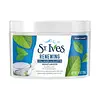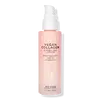What's inside
What's inside
 Key Ingredients
Key Ingredients

No key ingredients
 Benefits
Benefits

 Concerns
Concerns

 Ingredients Side-by-side
Ingredients Side-by-side

Water
Skin ConditioningParaffinum Liquidum
EmollientPropylene Glycol
HumectantPEG-100 Stearate
Glyceryl Stearate
EmollientStearic Acid
CleansingPhenoxyethanol
PreservativeCarthamus Tinctorius Seed Oil
MaskingTriethanolamine
BufferingCarbomer
Emulsion StabilisingDimethicone
EmollientCetyl Alcohol
EmollientDisodium EDTA
Parfum
MaskingEthylhexylglycerin
Skin ConditioningLinalool
PerfumingHexyl Cinnamal
PerfumingHydrolyzed Elastin
EmollientHydrolyzed Collagen
EmollientCoumarin
PerfumingGeraniol
PerfumingWater, Paraffinum Liquidum, Propylene Glycol, PEG-100 Stearate, Glyceryl Stearate, Stearic Acid, Phenoxyethanol, Carthamus Tinctorius Seed Oil, Triethanolamine, Carbomer, Dimethicone, Cetyl Alcohol, Disodium EDTA, Parfum, Ethylhexylglycerin, Linalool, Hexyl Cinnamal, Hydrolyzed Elastin, Hydrolyzed Collagen, Coumarin, Geraniol
Butyl Methoxydibenzoylmethane 3%
UV AbsorberHomosalate 15%
Skin ConditioningOctocrylene 10%
UV AbsorberEthylhexyl Salicylate 5%
UV AbsorberWater
Skin ConditioningButyloctyl Salicylate
Skin ConditioningCoconut Alkanes
EmollientCoco-Caprylate/Caprate
EmollientAloe Barbadensis Leaf Juice
Skin ConditioningGlycerin
HumectantHydrolyzed Jojoba Esters
Skin ConditioningGlyceryl Stearate
EmollientGlyceryl Stearate Citrate
EmollientSodium Stearoyl Glutamate
CleansingPolyglyceryl-4 Isostearate
EmulsifyingStearic Acid
CleansingLysolecithin
EmulsifyingSclerotium Gum
Emulsion StabilisingXanthan Gum
EmulsifyingPullulan
Hydrogenated Castor Oil
EmollientSr-Hydrozoan Polypeptide-1
HumectantSodium Hyaluronate
HumectantCitrus Aurantium Dulcis Flower Extract
Skin ConditioningJasminum Officinale Extract
MaskingChamomilla Recutita Flower Extract
MaskingArnica Montana Extract
Skin ConditioningSqualane
EmollientOryza Sativa Starch
AbsorbentBiosaccharide Gum-1
HumectantPhenoxyethanol
PreservativeEthylhexylglycerin
Skin ConditioningParfum
MaskingButyl Methoxydibenzoylmethane 3%, Homosalate 15%, Octocrylene 10%, Ethylhexyl Salicylate 5%, Water, Butyloctyl Salicylate, Coconut Alkanes, Coco-Caprylate/Caprate, Aloe Barbadensis Leaf Juice, Glycerin, Hydrolyzed Jojoba Esters, Glyceryl Stearate, Glyceryl Stearate Citrate, Sodium Stearoyl Glutamate, Polyglyceryl-4 Isostearate, Stearic Acid, Lysolecithin, Sclerotium Gum, Xanthan Gum, Pullulan, Hydrogenated Castor Oil, Sr-Hydrozoan Polypeptide-1, Sodium Hyaluronate, Citrus Aurantium Dulcis Flower Extract, Jasminum Officinale Extract, Chamomilla Recutita Flower Extract, Arnica Montana Extract, Squalane, Oryza Sativa Starch, Biosaccharide Gum-1, Phenoxyethanol, Ethylhexylglycerin, Parfum
 Reviews
Reviews

Ingredients Explained
These ingredients are found in both products.
Ingredients higher up in an ingredient list are typically present in a larger amount.
Ethylhexylglycerin (we can't pronounce this either) is commonly used as a preservative and skin softener. It is derived from glyceryl.
You might see Ethylhexylglycerin often paired with other preservatives such as phenoxyethanol. Ethylhexylglycerin has been found to increase the effectiveness of these other preservatives.
Glyceryl Stearate is a mix of glycerin and stearic acid.
It is used to stabilize the mixing of water and oil ingredients. By preventing these ingredients from separating, it can help elongate shelf life. It can also help thicken the product's texture.
As an emollient, it helps soften skin and supports barrier-replenishing ingredients.
In cosmetics, Glyceryl Stearate is often made from vegetable oils or synthetically produced.
This ingredient may not be fungal-acne safe
Fun fact: The human body also creates Glyceryl Stearate naturally.
Learn more about Glyceryl StearateParfum is a catch-all term for an ingredient or more that is used to give a scent to products.
Also called "fragrance", this ingredient can be a blend of hundreds of chemicals or plant oils. This means every product with "fragrance" or "parfum" in the ingredients list is a different mixture.
For instance, Habanolide is a proprietary trade name for a specific aroma chemical. When used as a fragrance ingredient in cosmetics, most aroma chemicals fall under the broad labeling category of “FRAGRANCE” or “PARFUM” according to EU and US regulations.
The term 'parfum' or 'fragrance' is not regulated in many countries. In many cases, it is up to the brand to define this term.
For instance, many brands choose to label themselves as "fragrance-free" because they are not using synthetic fragrances. However, their products may still contain ingredients such as essential oils that are considered a fragrance by INCI standards.
One example is Calendula flower extract. Calendula is an essential oil that still imparts a scent or 'fragrance'.
Depending on the blend, the ingredients in the mixture can cause allergies and sensitivities on the skin. Some ingredients that are known EU allergens include linalool and citronellol.
Parfum can also be used to mask or cover an unpleasant scent.
The bottom line is: not all fragrances/parfum/ingredients are created equally. If you are worried about fragrances, we recommend taking a closer look at an ingredient. And of course, we always recommend speaking with a professional.
Learn more about ParfumPhenoxyethanol is a preservative that has germicide, antimicrobial, and aromatic properties. Studies show that phenoxyethanol can prevent microbial growth. By itself, it has a scent that is similar to that of a rose.
It's often used in formulations along with Caprylyl Glycol to preserve the shelf life of products.
Stearic Acid is a fatty acid. It is an emollient, emulsifier, and texture enhancer.
As an emollient, stearic acid helps soften skin. It aids the skin's protective barrier by preventing water loss. It also provides a gentle cleansing effect without stripping away natural oils.
Stearic acid may also be used to enhance the texture of products. It can add volume and stabilize ingredients such as water and oil. This can help water and oil ingredients from separating.
Sources of stearic acid include animal or vegetable fats/oils such as coconut or shea. It can be naturally found in butter, cocoa butter, shea butter, vegetable fats, and animal tallow.
This ingredient may not be Malassezia folliculitis, or fungal-acne safe.
Learn more about Stearic AcidWater. It's the most common cosmetic ingredient of all. You'll usually see it at the top of ingredient lists, meaning that it makes up the largest part of the product.
So why is it so popular? Water most often acts as a solvent - this means that it helps dissolve other ingredients into the formulation.
You'll also recognize water as that liquid we all need to stay alive. If you see this, drink a glass of water. Stay hydrated!
Learn more about Water